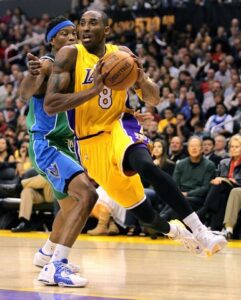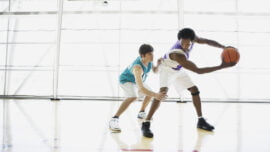Definition of Traveling in Basketball
Beginners players always looking for the answer about what is traveling in basketball. Traveling violation is a penalty in basketball that occurs when an offensive player in possession of the basketball makes an extra step or an illegal movement with their other pivoted foot.
It is one of the first rules many people learn when getting started with basketball. In other words, a traveling violation happens when a player holds the ball and moves his foot in illegally.
How many steps Consider is a travel violation?
In most cases, a travel violation foul happens when a basketball player makes more than two steps without dribbling the ball. But the player is allowed to move as far as he wants as long as he continues dribbling the ball.
In case a player completely stops, the right or the left foot becomes the pivot foot. Normally, the first foot to come off the ground is allowed to move while the other stays put.
Nonetheless, players are often allowed to take three steps toward the offensive play without necessarily dribbling the ball. For instance, a player may take three steps to dunk from a pass from a teammate due to his or her forward momentum.
Although this is typically a travel violation, it is upon the referee to make the final decision based on how the game is going.
A referee will always want to keep the flow of the game moving. That’s why they might choose to turn a blind eye to this travel violation. But they can still make this a travel violation if it is evident that the player is taking advantage of the three-step rule.
How NBA Referees Determine Travel Violations
Nearly all basketball leagues have traveling violation rules starting from NFHF to FIBA. Most of these regulations are the same.
They stipulate rules that determine a pivot foot that allows players to set one foot while keeping the one stationary. The rules put an illegal movement of the pivot foot that might trigger a travel violation.
If a player gets a pass when moving, he or she can take one gather step before taking the two steps normally used to determine a travel call. A gather can be described as any moment a player takes control of the ball. The player is allowed to touch the ball with both hands when gathering.
After gathering the ball, a player is permitted to take the first and second steps before trying to field a goal or relinquish ball possession. The NBA rules also stipulate who can get a hold of the ball after a field goal attempt.
For instance, the person shooting the ball should not be the first to touch the ball in case it fails to touch the backboard, hoop, or another player.
Pivot Foot
It is difficult to talk about traveling in basketball without mentioning the pivot foot. What is the pivot foot?
The pivot foot is the one foot (it can either be right or left) that must always remain stationary. Think of it as an anchor on the ground or floor. A basketball player has a right to spin on the pivot foot provided it remains within the same spot and doesn’t slide across the floor.
The pivot foot has to remain stationary on the floor provided the player is still in possession of the ball and is not jumping or dribbling into the air to pass or shoot the ball. Establishing a pivot foot is always key when it comes to determining a traveling call.
A pivot foot can only be established when a basketball player is standing in the same position as the ball. As soon as one-foot moves, the other one automatically becomes the pivot foot. If a player lands with the right foot, then the left foot becomes the pivot foot.
 But there are circumstances when there’s no pivot foot available. For instance after a “jump stop”. A jump stop happens when a player gets hold of the ball while in motion, touches the floor with one foot, jumps up, and lands on the floor with both feet.
But there are circumstances when there’s no pivot foot available. For instance after a “jump stop”. A jump stop happens when a player gets hold of the ball while in motion, touches the floor with one foot, jumps up, and lands on the floor with both feet.
In such a scenario, there’s no pivot foot since the player is unable to move either of his feet.
Rules of Travelling in Basketball
- Airball scenarios
- Early step
This is where a player takes a step and raises the pivot foot before passing the ball to the dribble. This is one of the common travel violations. It normally occurs when players are trying to move from a stationary position to the basket.
- Three-point-step
The three-point step is when a player receives the before the three-point line and falls back behind the line to score without dribbling. In case the player raises the pivot foot at this point, it becomes a travel violation.
There are however some instances where the referee can pardon the player depending on the momentum of the game
- Rebound reshuffle
This is where a player receives a rebound and reshuffles his feet or falls on the floor. Again, it is at the discretion of the referee to decide whether indeed the player has committed a traveling violation or not
- Illegal pivot foot movement
The person in possession of the ball must remain in the same position after picking up their dribble. Although they can move on an established pivot foot, they are forbidden from moving horizontally.
For instance, if a player lifts his foot, the right foot is now considered the pivot foot and is not allowed to move from that established position. In case of the pivot foot moves, the player will get a traveling call or penalty.
- Getting on the ground without passing or shooting
According to the guidelines from the National Collegiate Athletic Association (NCAA), in case a person jumps while in possession of the ball, the ball must leave his hands off before returning to the ground. Failing to do so will result in what is known as an “up and down” traveling violation.
- Rolling or standing up with the ball
This type of traveling violation is common in junior or lower-level basketball leagues. This is for the fact that loose balls scenarios are very frequent. When none of the teams is in possession, it is a live ball.
In case a player dives a live ball and takes its possession, they are not allowed to roll or try to stand without calling a timeout or passing the ball to a teammate.
Other Illegal Movements and Traveling Scenarios
- The Pivot slide: This is sliding or dragging the pivot foot while pivoting. It is a common scenario that players often get penalized for.
- Falling on the ground without maintaining the same pivoted position
- Rolling off the ground while still holding the ball
- Lifting both feet from the floor and coming down with one or both feet without releasing the ball.
All of the above scenarios constitute to traveling violation. Other than the above-mentioned scenarios, some rarely happen. One of them is when a player falls on the floor without dribbling or maintaining a pivot position.
A similar traveling call is made in case a player who has fallen on the floor stands up while still having possession of the ball without passing it or dribbling. Other scenarios include stepping back for a three-point shot as well as the rebound shuffle.
What is a Euro Step?
The Euro step is an offensive move that doesn’t go past the allowed two steps that a ball-handler can make in performing a dunk or layup. This means it doesn’t amount to a travel violation.
The ball handler normally makes the first step at an angle toward the basket while at the same time picking up his dribble. The player counters another step in an opposite direction to make enough space for the defender.
What is a Gathering Step?
A gathering step is a term used to describe extra steps allowed to gain ball control or continue toward the dribble, pass, or active shot.
What is the Penalty for a Traveling Violation?
The NCAA and NFHS have varied penalties for traveling violations compared to the NBA. In lower leagues traveling violation leads to a dead-ball foul. The opposing side is allowed to inbound the ball from out of bounds close to where the traveling foul happened.
If it is an offensive player commits a traveling foul in the NBA, the ball is given to the opposing team. But there are restrictions on where the team can be given the ball. NBA regulations stipulate that a team can get the ball not anywhere near the baseline and the three-throw line.
Criticism of Traveling in Basketball
Most fans are critical of how referees are lenient on traveling rules. Certain players deliberately violate traveling rules but are never penalized. Because of such criticism, the NBA has introduced some changes to its traveling rules.
The new changes are aimed at making the regulations clear and improving the accuracy of calls.
In a nutshell, a travel call happens when a player has the ball and still moves their fit. There are several other examples of travel violations. Sometimes it is at the discretion of a referee to decide whether to call for a travel violation or not.
Related Post



